Plant-based diet: Dietary Expansion, not Dietary Restriction
I came across an interesting interview with Donald Watson, an Englishman, responsible for coining the term vegan (which may be defined as, a way of living which seeks to exclude, as far as possible and practical, all forms of exploitation of, and cruelty to, animals for food, clothing or any other purpose) and may be considered the “father” of the vegan movement, particularly the animal ethics aspect of it, as we know it today.
When asked if he had an advice for the vegan community today he said:
“Take the broad view of what veganism stands for – something beyond finding a new
alternative to scrambled eggs on toast or a new recipe for Christmas cake.
Realise that you’re on to something really big, something that hadn’t been
tried
until sixty years ago, and something which is meeting every reasonable
criticism
that anyone can level against it. And this doesn’t involve weeks
or months of
studying diet charts or reading books by socalled experts – it means
grasping a few simple facts and applying them.”
I especially like the part about “grasping a few simple facts and applying them.” Achieving health through a wholesome, unrefined, plant-based diet is not difficult to understand or apply. In fact, it is quite simple and can be boiled down in essence to this: eat a wide variety of WHOLE plant foods daily, including grains, legumes, vegetables (including sea vegetables if possible), fruits, nuts/seeds, get a minimal amount of sun exposure (for vitamin D), and the only supplement you need is 5 mcg of B-12 a day. For most people, it really is that simple.
A lot of people think if you’re vegan you have dietary restrictions, or you’re limited in some way. I would say this is a mind set, not a reality, because my experience has been completely opposite. I have tried foods that I never would have tried if I were still eating the same variations on ground beef, chicken, cheese, and eggs.
Case in point, lets take a look into my kitchen (you can also see the video tour on the side bar if you’d like), quite a gutsy thing to do for any woman to do, even for me, who feels rather confident in my domestic skills. Notice the VARIETY I have of foods, certainly no two kitchens/pantries look alike, even vegan kitchens. I have to admit I love variety, so I’d say, the variety in my kitchen is more of exception than rule among whole foodists/vegans, but I may be wrong. Here’s a glimpse into just SOME, not all of the foods we eat at my house.
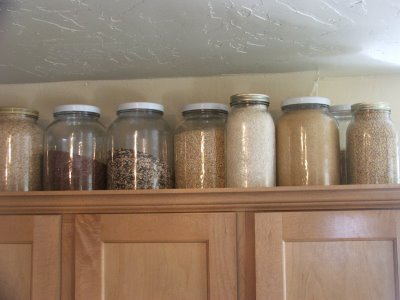 Brown Rice, Red Rice, Wild Rice, Sweet Brown Rice, Sticky White Rice, Amaranth, Barley
Brown Rice, Red Rice, Wild Rice, Sweet Brown Rice, Sticky White Rice, Amaranth, Barley
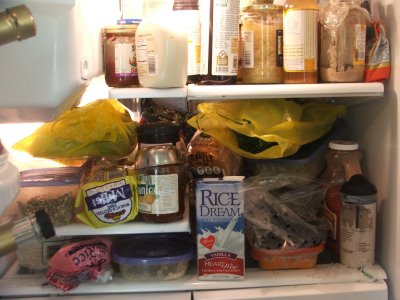 My fridge, quite crowded, full of produce, condiments, bread, milk, and other goodies… My favorite condiments include a good mustard, Tabasco sauce (both regular and chipotle), salsa, and A1 sauce.
My fridge, quite crowded, full of produce, condiments, bread, milk, and other goodies… My favorite condiments include a good mustard, Tabasco sauce (both regular and chipotle), salsa, and A1 sauce.
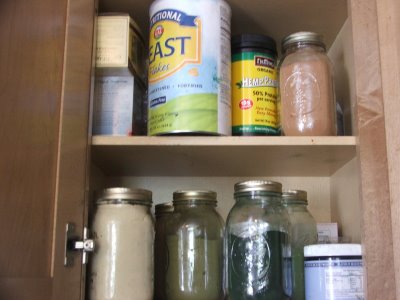 Green stevia leaf powder (for natural sweetness); hemp protein powder; herbal teas; carob and cocoa powders; nutritional yeast
Green stevia leaf powder (for natural sweetness); hemp protein powder; herbal teas; carob and cocoa powders; nutritional yeast
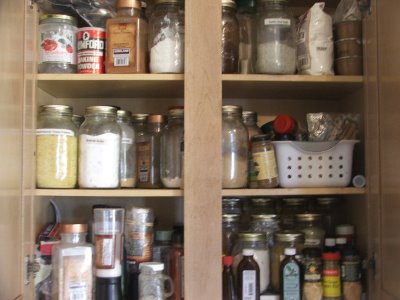 My herbs and spice cupboard. Some of my must have spices: cumin, chili powder, garlic and onion powder, all-purpose no salt organic seasoning mix, pepper grinder, xanthan gum (for gluten free baking), curry powder, dried basil and oregano.
My herbs and spice cupboard. Some of my must have spices: cumin, chili powder, garlic and onion powder, all-purpose no salt organic seasoning mix, pepper grinder, xanthan gum (for gluten free baking), curry powder, dried basil and oregano.
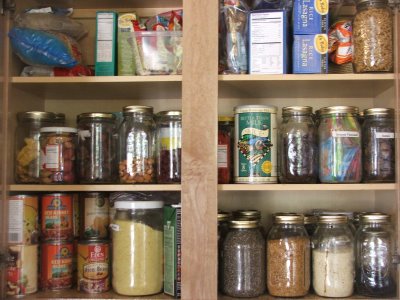 Another cupboard full of canned goods, mixes, dried fruit, nuts, seeds, and more pasta & rice noodles. Some of my favorite things in this cupboard: chia seeds, golden flax seeds, dried figs, dates, prunes, almond butter…
Another cupboard full of canned goods, mixes, dried fruit, nuts, seeds, and more pasta & rice noodles. Some of my favorite things in this cupboard: chia seeds, golden flax seeds, dried figs, dates, prunes, almond butter…
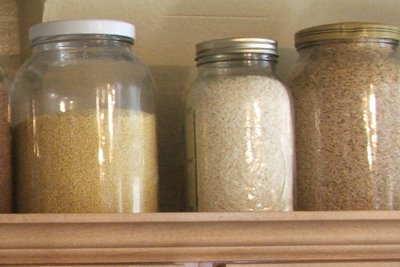 Millet, white rice, long grain brown rice. Amaranth, oatmeal, oat groats, and quinoa are some other grains we enjoy but are not pictured here.
Millet, white rice, long grain brown rice. Amaranth, oatmeal, oat groats, and quinoa are some other grains we enjoy but are not pictured here.I store all of these grains in gallon glass jars, purchased from Azure Standard. Love how I can see what’s in everything. Makes it breeze to find what I want and it looks pretty too!
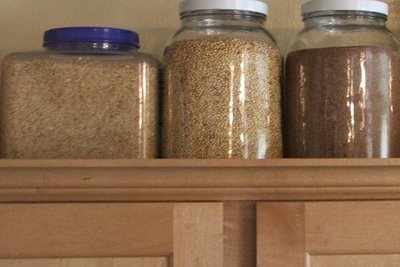 Brown basmati rice, sorghum (a great gluten free grain made into flour), teff grain
Brown basmati rice, sorghum (a great gluten free grain made into flour), teff grain
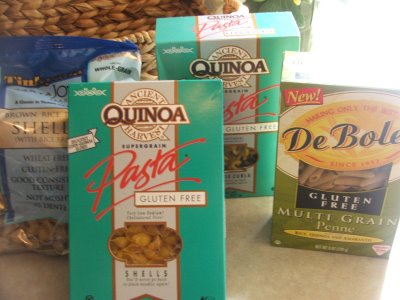 A various assortment of wheat/gluten free pastas made of rice, quinoa, corn, amaranth
A various assortment of wheat/gluten free pastas made of rice, quinoa, corn, amaranth
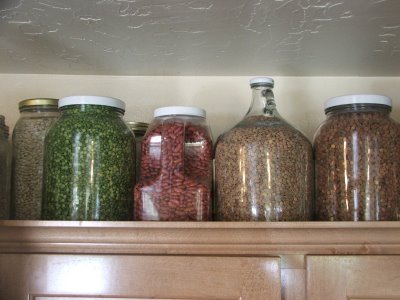 Navy beans, split peas, kidney beans, brown lentils, chana dal garbanzo beans
Navy beans, split peas, kidney beans, brown lentils, chana dal garbanzo beans
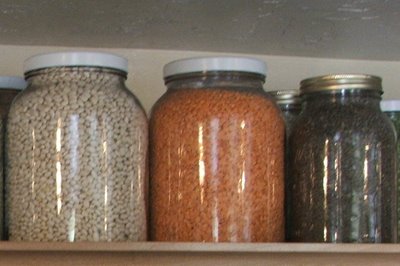 Great northern beans, red lentils, french lentils
Great northern beans, red lentils, french lentils
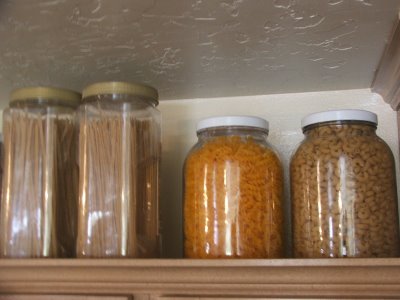 Brown rice spaghetti noodles, brown rice fettuccine, corn spiral noodles, brown rice elbows
Brown rice spaghetti noodles, brown rice fettuccine, corn spiral noodles, brown rice elbows
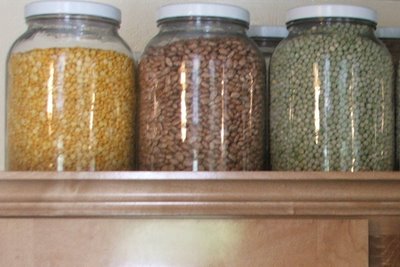 Yellow split peas, pinto beans, dried peas
Yellow split peas, pinto beans, dried peas
I buy most of my grains and legumes in bulk from Azure Standard. This is by far the least inexpensive way to eat, as grains/legumes/nuts/seeds in bulk are so much cheaper than anything processed. For example, I bought a 25 lb. bag of split peas for $10, which is roughly 40 cents a pound. One pound can make up to 12 servings, which would be about 3.5 cents a serving!
Nearly free food in comparison to a frozen pizza.
As you can see, by taking less desirable foods out of your diet, you make room for better, more health promoting foods. Coleen Patrick-Goudreau, a vegan cookbook author, suggests that when we say we crave meat, we’re not craving the flesh of an animal but rather those things that meat can provide, namely texture, fat and salt. You can find these in plant foods, especially with a little help from herbs, spices, and higher-fat plant foods such as olives, nuts, avacados, and if in small amounts, quality plant oils.
Instead of flesh foods/meat try:
beans, such as garbanzo beans, lentils, split peas, pinto beans, white beans, kidney beans
tofu or tempeh
Instead of cow’s milk try:
Rice, almond, hazelnut, oat, banana, soy, coconut milk, all of which come in a variety of flavors
Instead of dairy cheese try:
Soy, rice, or almond cheese
Crumbled tofu
Finely ground cashews or toasted pinenuts or sesame seeds
Instead of dairy butter try:
Earth balance buttery spread, Best Life Spread, Smart Balance spread (the vegan kind), all non-hydrogenated vegan spreads or try apple butter
Instead of dairy yogurt try:
Soy, coconut or even almond based yogurt
Instead of dairy ice cream try:
rice, soy, or coconut icecream (My favorite brand is So Delicious)
Instead of refined sugar try:
Sucanant, date sugar, maple syrup, brown rice syrup, agave nectar, stevia, Truvia (white stevia), molasses
Remember, the options are really limitless, and even if you live in an area where there are limited options as to specialty vegan foods (like soy yogurt), there’s always still options in terms of grains, legumes, vegetables, and fruits.
Brown Rice, Red Rice, Wild Rice, Sweet Brown Rice, Sticky White Rice, Amaranth, Barley
My fridge, quite crowded, full of produce, condiments, bread, milk, and other goodies… My favorite condiments include a good mustard, Tabasco sauce (both regular and chipotle), salsa, and A1 sauce.



Comments